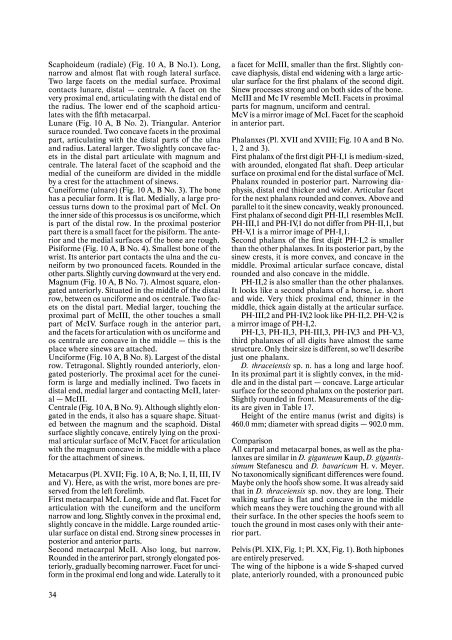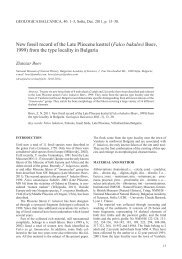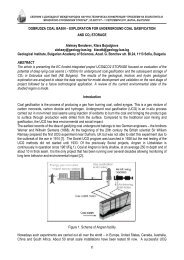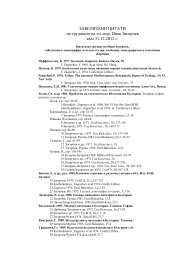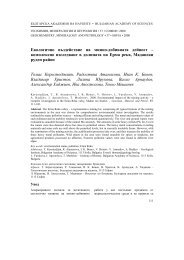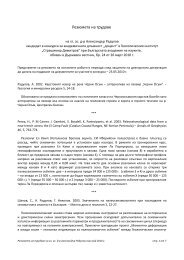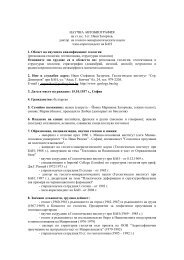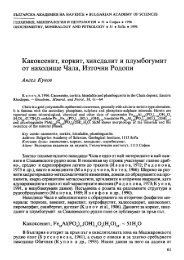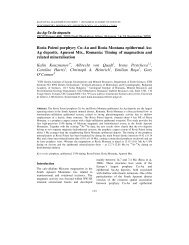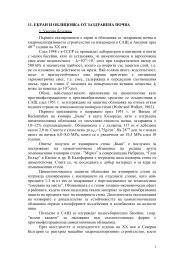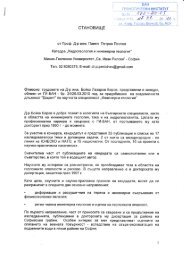Deinotherium thraceiensis sp. nov. from the Miocene near Ezerovo ...
Deinotherium thraceiensis sp. nov. from the Miocene near Ezerovo ...
Deinotherium thraceiensis sp. nov. from the Miocene near Ezerovo ...
You also want an ePaper? Increase the reach of your titles
YUMPU automatically turns print PDFs into web optimized ePapers that Google loves.
Scaphoideum (radiale) (Fig. 10 A, B No.1). Long,<br />
narrow and almost flat with rough lateral surface.<br />
Two large facets on <strong>the</strong> medial surface. Proximal<br />
contacts lunare, distal – centrale. A facet on <strong>the</strong><br />
very proximal end, articulating with <strong>the</strong> distal end of<br />
<strong>the</strong> radius. The lower end of <strong>the</strong> scaphoid articulates<br />
with <strong>the</strong> fifth metacarpal.<br />
Lunare (Fig. 10 A, B No. 2). Triangular. Anterior<br />
surace rounded. Two concave facets in <strong>the</strong> proximal<br />
part, articulating with <strong>the</strong> distal parts of <strong>the</strong> ulna<br />
and radius. Lateral larger. Two slightly concave facets<br />
in <strong>the</strong> distal part articulate with magnum and<br />
centrale. The lateral facet of <strong>the</strong> scaphoid and <strong>the</strong><br />
medial of <strong>the</strong> cuneiform are divided in <strong>the</strong> middle<br />
by a crest for <strong>the</strong> attachment of sinews.<br />
Cuneiforme (ulnare) (Fig. 10 A, B No. 3). The bone<br />
has a peculiar form. It is flat. Medially, a large processus<br />
turns down to <strong>the</strong> proximal part of McI. On<br />
<strong>the</strong> inner side of this processus is os unciforme, which<br />
is part of <strong>the</strong> distal row. In <strong>the</strong> proximal posterior<br />
part <strong>the</strong>re is a small facet for <strong>the</strong> pisiform. The anterior<br />
and <strong>the</strong> medial surfaces of <strong>the</strong> bone are rough.<br />
Pisiforme (Fig. 10 A, B No. 4). Smallest bone of <strong>the</strong><br />
wrist. Its anterior part contacts <strong>the</strong> ulna and <strong>the</strong> cuneiform<br />
by two pronounced facets. Rounded in <strong>the</strong><br />
o<strong>the</strong>r parts. Slightly curving downward at <strong>the</strong> very end.<br />
Magnum (Fig. 10 A, B No. 7). Almost square, elongated<br />
anteriorly. Situated in <strong>the</strong> middle of <strong>the</strong> distal<br />
row, between os unciforme and os centrale. Two facets<br />
on <strong>the</strong> distal part. Medial larger, touching <strong>the</strong><br />
proximal part of McIII, <strong>the</strong> o<strong>the</strong>r touches a small<br />
part of McIV. Surface rough in <strong>the</strong> anterior part,<br />
and <strong>the</strong> facets for articulation with os unciforme and<br />
os centrale are concave in <strong>the</strong> middle – this is <strong>the</strong><br />
place where sinews are attached.<br />
Unciforme (Fig. 10 A, B No. 8). Largest of <strong>the</strong> distal<br />
row. Tetragonal. Slightly rounded anteriorly, elongated<br />
posteriorly. The proximal acet for <strong>the</strong> cuneiform<br />
is large and medially inclined. Two facets in<br />
distal end, medial larger and contacting McII, lateral<br />
– McIII.<br />
Centrale (Fig. 10 A, B No. 9). Although slightly elongated<br />
in <strong>the</strong> ends, it also has a square shape. Situated<br />
between <strong>the</strong> magnum and <strong>the</strong> scaphoid. Distal<br />
surface slightly concave, entirely lying on <strong>the</strong> proximal<br />
articular surface of McIV. Facet for articulation<br />
with <strong>the</strong> magnum concave in <strong>the</strong> middle with a place<br />
for <strong>the</strong> attachment of sinews.<br />
Metacarpus (Pl. XVII; Fig. 10 A, B; No. I, II, III, IV<br />
and V). Here, as with <strong>the</strong> wrist, more bones are preserved<br />
<strong>from</strong> <strong>the</strong> left forelimb.<br />
First metacarpal McI. Long, wide and flat. Facet for<br />
articulation with <strong>the</strong> cuneiform and <strong>the</strong> unciform<br />
narrow and long. Slightly convex in <strong>the</strong> proximal end,<br />
slightly concave in <strong>the</strong> middle. Large rounded articular<br />
surface on distal end. Strong sinew processes in<br />
posterior and anterior parts.<br />
Second metacarpal McII. Also long, but narrow.<br />
Rounded in <strong>the</strong> anteriror part, strongly elongated posteriorly,<br />
gradually becoming narrower. Facet for unciform<br />
in <strong>the</strong> proximal end long and wide. Laterally to it<br />
34<br />
a facet for McIII, smaller than <strong>the</strong> first. Slightly concave<br />
diaphysis, distal end widening with a large articular<br />
surface for <strong>the</strong> first phalanx of <strong>the</strong> second digit.<br />
Sinew processes strong and on both sides of <strong>the</strong> bone.<br />
McIII and Mc IV resemble McII. Facets in proximal<br />
parts for magnum, unciform and central.<br />
McV is a mirror image of McI. Facet for <strong>the</strong> scaphoid<br />
in anterior part.<br />
Phalanxes (Pl. XVII and XVIII; Fig. 10 A and B No.<br />
1, 2 and 3).<br />
First phalanx of <strong>the</strong> first digit PH-I,1 is medium-sized,<br />
with arounded, elongated flat shaft. Deep articular<br />
surface on proximal end for <strong>the</strong> distal surface of McI.<br />
Phalanx rounded in posterior part. Narrowing diaphysis,<br />
distal end thicker and wider. Articular facet<br />
for <strong>the</strong> next phalanx rounded and convex. Above and<br />
parallel to it <strong>the</strong> sinew concavity, weakly pronounced.<br />
First phalanx of second digit PH-II,1 resembles McII.<br />
PH-III,1 and PH-IV,1 do not differ <strong>from</strong> PH-II,1, but<br />
PH-V,1 is a mirror image of PH-I,1.<br />
Second phalanx of <strong>the</strong> first digit PH-I,2 is smaller<br />
than <strong>the</strong> o<strong>the</strong>r phalanxes. In its posterior part, by <strong>the</strong><br />
sinew crests, it is more convex, and concave in <strong>the</strong><br />
middle. Proximal articular surface concave, distal<br />
rounded and also concave in <strong>the</strong> middle.<br />
PH-II,2 is also smaller than <strong>the</strong> o<strong>the</strong>r phalanxes.<br />
It looks like a second phalanx of a horse, i.e. short<br />
and wide. Very thick proximal end, thinner in <strong>the</strong><br />
middle, thick again distally at <strong>the</strong> articular surface.<br />
PH-III,2 and PH-IV,2 look like PH-II,2. PH-V,2 is<br />
a mirror image of PH-I,2.<br />
PH-I,3, PH-II,3, PH-III,3, PH-IV,3 and PH-V,3,<br />
third phalanxes of all digits have almost <strong>the</strong> same<br />
structure. Only <strong>the</strong>ir size is different, so we’ll describe<br />
just one phalanx.<br />
D. <strong>thraceiensis</strong> <strong>sp</strong>. n. has a long and large hoof.<br />
In its proximal part it is slightly convex, in <strong>the</strong> middle<br />
and in <strong>the</strong> distal part – concave. Large articular<br />
surface for <strong>the</strong> second phalanx on <strong>the</strong> posterior part.<br />
Slightly rounded in front. Measurements of <strong>the</strong> digits<br />
are given in Table 17.<br />
Height of <strong>the</strong> entire manus (wrist and digits) is<br />
460.0 mm; diameter with <strong>sp</strong>read digits – 902.0 mm.<br />
Comparison<br />
All carpal and metacarpal bones, as well as <strong>the</strong> phalanxes<br />
are similar in D. giganteum Kaup, D. gigantissimum<br />
Stefanescu and D. bavaricum H. v. Meyer.<br />
No taxonomically significant differences were found.<br />
Maybe only <strong>the</strong> hoofs show some. It was already said<br />
that in D. <strong>thraceiensis</strong> <strong>sp</strong>. <strong>nov</strong>. <strong>the</strong>y are long. Their<br />
walking surface is flat and concave in <strong>the</strong> middle<br />
which means <strong>the</strong>y were touching <strong>the</strong> ground with all<br />
<strong>the</strong>ir surface. In <strong>the</strong> o<strong>the</strong>r <strong>sp</strong>ecies <strong>the</strong> hoofs seem to<br />
touch <strong>the</strong> ground in most cases only with <strong>the</strong>ir anterior<br />
part.<br />
Pelvis (Pl. XIX, Fig. 1; Pl. XX, Fig. 1). Both hipbones<br />
are entirely preserved.<br />
The wing of <strong>the</strong> hipbone is a wide S-shaped curved<br />
plate, anteriorly rounded, with a pronounced pubic


